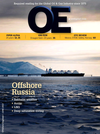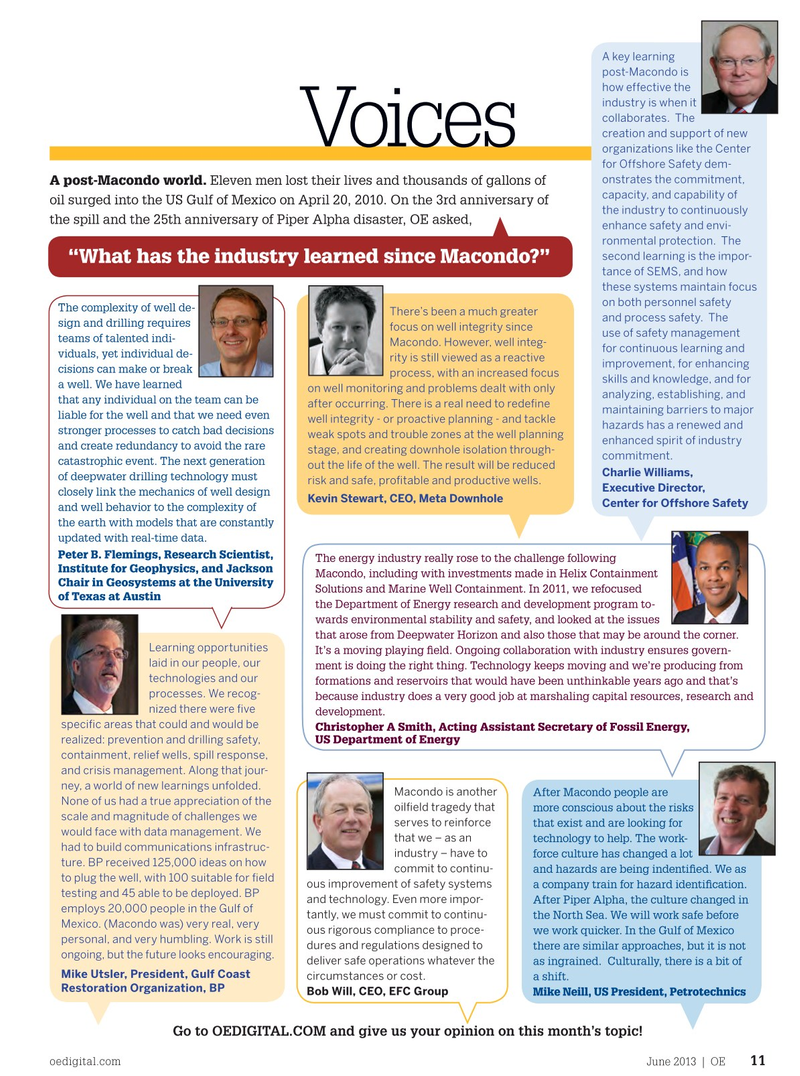
Page 9: of Offshore Engineer Magazine (Jun/Jul 2013)
Read this page in Pdf, Flash or Html5 edition of Jun/Jul 2013 Offshore Engineer Magazine
A key learning post-Macondo is how effective the industry is when it collaborates. The creation and support of new Voices organizations like the Center for Offshore Safety dem- onstrates the commitment,
A post-Macondo world. Eleven men lost their lives and thousands of gallons of capacity, and capability of oil surged into the US Gulf of Mexico on April 20, 2010. On the 3rd anniversary of the industry to continuously the spill and the 25th anniversary of Piper Alpha disaster, OE asked, enhance safety and envi- ronmental protection. The second learning is the impor- “What has the industry learned since Macondo?” tance of SEMS, and how these systems maintain focus on both personnel safety
The complexity of well de-
There’s been a much greater and process safety. The sign and drilling requires focus on well integrity since use of safety management teams of talented indi-
Macondo. However, well integ- for continuous learning and viduals, yet individual de- rity is still viewed as a reactive improvement, for enhancing cisions can make or break process, with an increased focus skills and knowledge, and for a well. We have learned on well monitoring and problems dealt with only analyzing, establishing, and that any individual on the team can be after occurring. There is a real need to redefne maintaining barriers to major liable for the well and that we need even well integrity - or proactive planning - and tackle hazards has a renewed and stronger processes to catch bad decisions weak spots and trouble zones at the well planning enhanced spirit of industry and create redundancy to avoid the rare stage, and creating downhole isolation through- commitment.
catastrophic event. The next generation out the life of the well. The result will be reduced
Charlie Williams, of deepwater drilling technology must risk and safe, proftable and productive wells.
Executive Director, closely link the mechanics of well design
Kevin Stewart, CEO, Meta Downhole
Center for Offshore Safety and well behavior to the complexity of the earth with models that are constantly updated with real-time data.
Peter B. Flemings, Research Scientist,
The energy industry really rose to the challenge following
Institute for Geophysics, and Jackson
Macondo, including with investments made in Helix Containment
Chair in Geosystems at the University
Solutions and Marine Well Containment. In 2011, we refocused of Texas at Austin the Department of Energy research and development program to- wards environmental stability and safety, and looked at the issues that arose from Deepwater Horizon and also those that may be around the corner.
Learning opportunities
It’s a moving playing feld. Ongoing collaboration with industry ensures govern- laid in our people, our ment is doing the right thing. Technology keeps moving and we’re producing from technologies and our formations and reservoirs that would have been unthinkable years ago and that’s processes. We recog- because industry does a very good job at marshaling capital resources, research and nized there were fve development.
specifc areas that could and would be
Christopher A Smith, Acting Assistant Secretary of Fossil Energy, realized: prevention and drilling safety, US Department of Energy containment, relief wells, spill response, and crisis management. Along that jour- ney, a world of new learnings unfolded.
Macondo is another After Macondo people are
None of us had a true appreciation of the oilfeld tragedy that more conscious about the risks scale and magnitude of challenges we serves to reinforce that exist and are looking for would face with data management. We that we – as an technology to help. The work- had to build communications infrastruc- industry – have to force culture has changed a lot ture. BP received 125,000 ideas on how commit to continu- and hazards are being indentifed. We as to plug the well, with 100 suitable for feld ous improvement of safety systems a company train for hazard identifcation. testing and 45 able to be deployed. BP and technology. Even more impor- After Piper Alpha, the culture changed in employs 20,000 people in the Gulf of tantly, we must commit to continu- the North Sea. We will work safe before
Mexico. (Macondo was) very real, very ous rigorous compliance to proce- we work quicker. In the Gulf of Mexico personal, and very humbling. Work is still dures and regulations designed to there are similar approaches, but it is not ongoing, but the future looks encouraging.
deliver safe operations whatever the as ingrained. Culturally, there is a bit of
Mike Utsler, President, Gulf Coast circumstances or cost. a shift.
Restoration Organization, BP
Bob Will, CEO, EFC Group
Mike Neill, US President, Petrotechnics
Go to OEDIGITAL.COM and give us your opinion on this month’s topic!
oedigital.com June 2013 | OE 11 011_06OE_voices.indd 11 5/25/13 12:34 AM

 8
8

 10
10